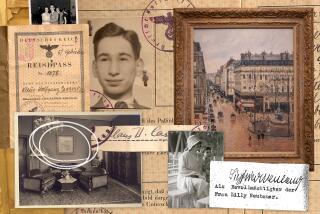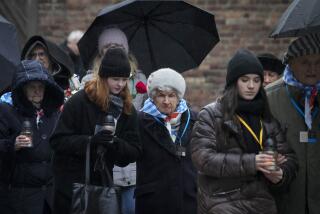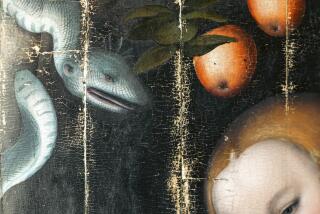Jewish artifacts believed to be from Kristallnacht
KLANDORF, GERMANY — Sometimes serendipity makes history. In this case, it may have uncovered history.
This year, Israeli writer Yaron Svoray came to Germany to research the underground operation that whisked Nazi officials to South America to escape justice after World War II. Svoray was chatting with a local about his project when the man mentioned that a nearby plot of land had served as a dump during the Third Reich.
The man said items looted during the pogrom known as Kristallnacht, or “Night of Broken Glass,” were disposed of there. Thousands of Jewish homes, shops and synagogues were ransacked and burned that night 70 years ago today in an orgy of hatred considered by many to be the start of the Holocaust.
Svoray’s investigative instincts were immediately aroused. On return trips, he examined old maps to confirm the dump’s location here in Klandorf, about 40 miles north of Berlin. In May, he went to the site, now thick with tall grasses, picked a spot at random and dug.
“We just pointed to one heap and said, ‘Let’s start,’ ” Svoray recalled. “Within an hour I had a [metal] swastika in my hand and Jewish porcelain and a bottle with a Star of David, which could have been a Jewish wine bottle.”
Historians in Israel judged the finds to be authentic prewar pieces, enhancing the possibility that Svoray may have stumbled on a trove of Nazi-era artifacts, including rare physical evidence of Kristallnacht.
Svoray, the son of Holocaust survivors, has organized a traditional Jewish service at the dump site to mark and mourn the brutality of the Nov. 9, 1938, pogrom.
But beyond remembrance, his goal is to prod the German government into action. Since he went public with his discoveries last month, Svoray said, nothing has been done to protect the site from looters, and authorities have shown no interest in investigating further.
“There is enough stuff here to warrant an initial search,” Svoray said by telephone from Israel recently. “And the initial search cannot be done by neo-Nazis after drinking beer on a Friday night and then putting it up for sale on EBay.”
The dump site sprawls across several acres, an uneven terrain of wooded copses and bushy ravines. Wooden watchtowers jut out from the overgrowth, lookouts for hunters who come in search of wild boar and deer.
For Svoray, an author whose book on neo-Nazism was turned into a TV movie in the U.S. in the 1990s, knowledge of the dump site came as a surprise.
Not so for some residents of Klandorf, a quiet village of about 200 people where unfamiliar cars can attract curious stares from behind curtained windows.
Arno Gielsdorf, a burly, friendly mechanic whose family has lived here for 150 years, owns some of the land that the dump site occupies. He has always known of its existence.
“My father told me that [at the time] the population from the town would scavenge what was useful,” said Gielsdorf, 49, adding that his grandparents went out there “almost every day,” picking up silver utensils, tankards and other reusable scraps.
That is, until the day authorities abruptly barred people from the dump.
It was November 1938.
“For several days we didn’t know what was happening,” Gielsdorf said his father, who died in 2001, told him. “At this time of the Reichspogrom [Kristallnacht], it was forbidden to go there and take out what you wanted.”
The refuse pit in use then was 25 feet deep. But when residents were finally allowed back in, “it was covered with regular garbage, so that nobody could get to the items beneath,” Gielsdorf said.
If physical evidence of what happened the night of Nov. 9 was indeed brought here, from Berlin or beyond, there may have been plenty of it.
Rampaging Germans smashed the windows of Jewish houses and businesses, giving Kristallnacht its name. Temples were desecrated, their furnishings tossed into the streets or set ablaze. Inspired by Adolf Hitler’s fanatical fascism, rioters pulled Jews from their homes, destroyed their belongings and beat some of them senseless, in a campaign of violence that the Nazis said was spontaneous but was in fact cultivated and encouraged by the regime.
At least 91 Jews were killed, and 30,000 were arrested and sent to camps in Buchenwald, Sachsenhausen and Dachau.
“It’s really the turning point of the intensification of the violence against Jews in Nazi Germany,” said Ann Millin, a historian at the U.S. Holocaust Memorial Museum in Washington.
Positively identifying any finds as property plundered from Jews on Kristallnacht and not simply thrown out or confiscated at some other date would be difficult.
Svoray said, “If someone says, will you find a piece of paper saying, ‘Save me,’ . . . from the 9th of November? I think not.”
But “if someone says I can’t start a dig until I know it’s Kristallnacht, that’s nonsense,” he added. “You have enough evidence to make a serious undertaking.”
Exposed and half-buried artifacts are certainly not hard to find.
On a recent visit by a foreign reporter, after a day of heavy rain, one small patch of the dump site was littered with jagged shards of porcelain, a delicate pink floral pattern still visible on one piece. Bottles made of colored glass, which might once have held perfume or a tonic, were strewn about.
Within minutes of scraping at a small mound of dirt, Ako Hintzen, a bodyguard who travels with Svoray in Germany, unearthed an old bottle with the raised inscription “Apotheke Zander,” a pharmacy. Another large bottle bore the name “Josef” and a worn-away surname, plus the word “Berlin” and the charming figure of a cat.
The items Svoray found last spring, including the bottle with the Star of David, were taken to the Ghetto Fighters’ House museum in Israel, which documents Jewish resistance to the Nazis. Museum officials examined the pieces and pronounced them genuine prewar objects, although lab results of some kind would be more conclusive, said Simcha Stein, the museum’s director.
“I was so excited,” Stein said. “It was like a scream [from the past] in front of my eyes.”
He acknowledged the problems in trying to determine the artifacts’ provenance.
“To tell you that this part of the bottle was taken from this Jewish table, from this street, from this family -- I can’t tell you that. But that’s not important,” Stein said. “What is important is that it can be another way to bring the Holocaust story” to life and to the attention of a new generation of young people.
That is something Svoray too would like to see. But it will take the resources of the German government to make it happen: to secure the site, which he identifies as the first priority, and then to mount an excavation.
“I’m convinced that this is a worthwhile historical, academic endeavor. There is no downside to it,” Svoray said. “I will not rest until this becomes a proper historical investigation.”
--
More to Read
Sign up for Essential California
The most important California stories and recommendations in your inbox every morning.
You may occasionally receive promotional content from the Los Angeles Times.











